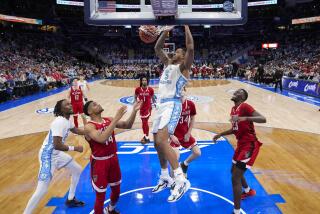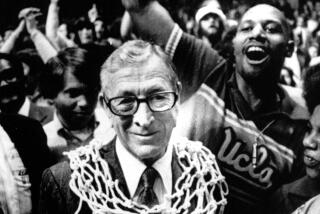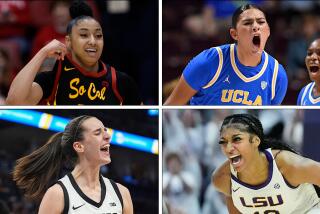The agony and ecstasy of NCAA tournament Selection Sunday
- Share via
The hours before Selection Sunday are what Lakers announcer Chick Hearn used to call “nervous time.”
Defending national champion Kentucky might want to chew on some of Jerry Tarkanian’s old towels after probably blowing its bubble bid with an early SEC tournament ouster against Vanderbilt.
Kentucky Coach John Calipari needs to move Sunday morning’s team breakfast into the beggars banquet room.
Those eight NCAA titles are of little use now.
“The good news is everyone seems to be losing,” Calipari said after his team “laid an egg” against Vandy. “I just hope we’re the best of the bad right now.”
Sorry, boys, but it looks as if you’re going from national champs to NIT.
Members of the NCAA basketball selection committee, currently snuffing out dreams and cigarette butts in Indianapolis, can’t be sentimentalists.
Their coldblooded mandate is to take 31 automatic conference bid winners and weave them into a 68-team symphony. It matters not that one conference champion, Liberty, has a 15-20 record.
The committee selects 37 at-large schools to feed and seed into a geographically considered bracket.
The great misnomer is that the NCAA tournament determines the best team every year. It doesn’t even include the best 68 teams. The tournament is not a playoff, but rather a Big Tent circus “event” that ends with syrupy music and a confetti drop.
Before you complain that your alma mater was biblically robbed, understand the ground rules.
Only 68 schools get in: The tournament expanded in 2010 to provide more entry access. Eight schools will play into four spots in Dayton, Ohio, early next week. The four worst automatic qualifiers (give us Liberty) spar for two No. 16 seats at the table while the last four at-large teams play for two spots on the No. 12 line.
The top four lines in the bracket curve get preferential placement.
“They’ve earned that position throughout the regular season,” Mike Bobinski, chairman of the NCAA selection committee, said last week.
The top four at this minute appear to be Indiana (Midwest), Louisville (East), Duke (South) and Gonzaga (West).
Wait another minute, though, didn’t Duke just lose to Maryland in the ACC tournament in a game that prompted Coach Mike Krzyzewski to say “I didn’t think we were hungry tonight”?
Yeah, well, but Duke is still Duke, although the Blue Devils are now vulnerable to being overtaken for a No. 1 regional seeding.
Indiana, despite Saturday’s loss to Wisconsin, probably remains a No. 1 and makes a short, Wright Brothers Airlines puddle jump to Dayton for a subregional. Louisville gets spoon-fed to nearby Lexington, Ky., with Gonzaga receiving the time-zone break to Salt Lake City and Duke probably heading to Philadelphia.
Bracket doctrine dictates the top three schools from a conference must go to different regionals. The committee desperately tries to prevent same-league schools from meeting until the regional finals.
And never forget this: Injuries matter.
Kentucky is probably out because it is only 4-4 since losing star freshman Nerlens Noel to a knee injury.
“We know when players were and weren’t available,” Bobinski said.
Duke can still defend a No. 1 slot because it has lost only one game with Ryan Kelly, who was lost for weeks because of a foot injury, in the lineup.
UCLA won the Pac-12 regular-season title and defeated Arizona three times but might still be seeded lower because of the broken foot suffered Friday night by starter Jordan Adams.
The court precedent is “Kenyon Martin vs. NCAA field” in 2000, when top-ranked Cincinnati lost its superstar center to a broken leg in the Conference USA tournament. Bearcats fans were outraged when the committee demoted Cincinnati to the No. 2 line, but the bottom line was Cincinnati wasn’t the same team without Martin and proved it with a second-round loss to seventh-seeded Tulsa.
Bracket predictor Jerry Palm of CBSSports.com has UCLA as a No. 7 in the South playing No. 10 Minnesota in Kansas City, Mo. He has Arizona seeded higher at No. 4 in the East but getting a first-round pod visit to San Jose.
ESPN’s bracket man Joe Lunardi on Saturday afternoon had UCLA and Arizona at No. 5 with UCLA in the East (in San Jose) and Arizona in the South (in Salt Lake City).
This week’s deluge of “best of the bad” mid-range battles has already sorted out many potential selection arguments.
Iowa squandered a great at-large chance by blowing a big lead against Michigan State in the Big Ten tournament.
St. Mary’s sat nervously on the bubble after Monday’s blowout loss to No. 1 Gonzaga in the West Coast Conference tournament final. The Gaels have lost to only one team in 2013 — to Gonzaga, three times — but are probably safely in the field after the latest round of convulsions.
Maryland made its inclusion case with its win over Duke, but then lost to North Carolina in the ACC semifinals.
What about Middle Tennessee, which boasts a glossy 28-5 record and RPI ranking of 29, but lost in the semifinals of the Sun Belt tournament to Florida International?
Just the idea of Kentucky and Middle Tennessee sweating it out in the same NCAA steam room makes Sunday’s selection show worth watching.
More to Read
Go beyond the scoreboard
Get the latest on L.A.'s teams in the daily Sports Report newsletter.
You may occasionally receive promotional content from the Los Angeles Times.











